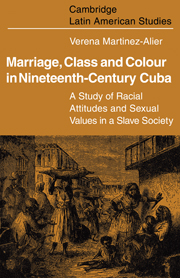 Marriage, Class and Colour in Nineteenth Century Cuba
Marriage, Class and Colour in Nineteenth Century Cuba Book contents
- Frontmatter
- Contents
- Preface
- List of abbreviations
- INTRODUCTION
- PART ONE INTERRACIAL MARRIAGE
- 1 Intermarriage and family honour
- 2 Intermarriage and politics
- 3 Intermarriage and Catholic doctrine
- 4 The white man's view
- 5 Colour as a symbol of social status
- 6 Intraracial marriage
- PART TWO HONOUR AND CLASS
- Appendix: Three Cuban genealogies
- Notes to the text
- Bibliography
- Index
2 - Intermarriage and politics
Published online by Cambridge University Press: 09 October 2009
- Frontmatter
- Contents
- Preface
- List of abbreviations
- INTRODUCTION
- PART ONE INTERRACIAL MARRIAGE
- 1 Intermarriage and family honour
- 2 Intermarriage and politics
- 3 Intermarriage and Catholic doctrine
- 4 The white man's view
- 5 Colour as a symbol of social status
- 6 Intraracial marriage
- PART TWO HONOUR AND CLASS
- Appendix: Three Cuban genealogies
- Notes to the text
- Bibliography
- Index
Summary
PRIVATE PURITY
It is surely the effect interracial marriage was felt to have on family prestige which led the authorities to insist on finding out whether the white candidate possessed any relatives in Cuba or in Spain who might object to the match before granting the licence. Some general guidelines which governed decisions on mixed marriages in roughly the first half of the nineteenth century are summed up by the official who demanded that ‘reports be obtained on whether Maria Justa B. although parda is freeborn and her parents are the same, and on whether her conduct is respectable; with regard to the tailor José Flores, who is said to be from Cadiz, whether he has any relatives here who could be shamed and offended by a marriage with the said [girl]’.
Thus, one aspect that is inquired into in the requisite reports on the candidates is the existence or non-existence of relatives on the part of the white party to the intended marriage ‘who could be put to shame or offended by [it]’. Significant is an official's telling remark that ‘the licence that M.'s father sent in granting her his consent to marry R. is sufficient proof of the equality of the two’. She is said to be white whereas her suitor is reputed to be coloured. The official's reasoning is that marriage is only for likes, since the father agrees they must be equals. The law pays due attention to this interdependence of family honour and that of its members. If one member of a family were to contract an unsuitable marriage this was sufficient to damage permanently the social prestige of the whole family.
- Type
- Chapter
- Information
- Marriage, Class and Colour in Nineteenth Century CubaA Study of Racial Attitudes and Sexual Values in a Slave Society, pp. 20 - 41Publisher: Cambridge University PressPrint publication year: 1974


